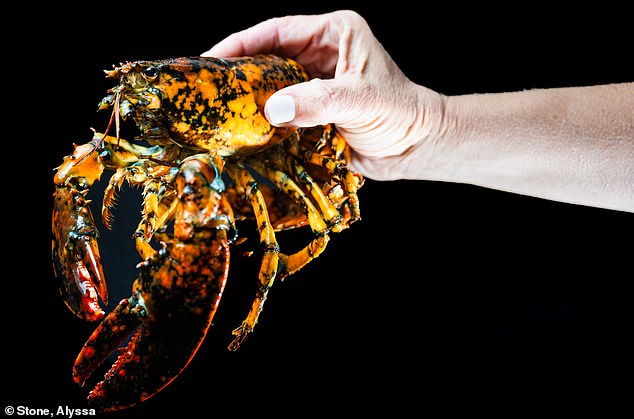An ultra-rare freckled lobster has shocked fishermen after being caught off the Massachusetts coast.
The unusual female lobster has a fancy ‘calico’ pattern – bright orange with drizzles of black and touches of yellow.
Odds of catching a calico lobster are believed to be only one in 30 million, according to local experts, who have named the creature Jackie.
Such an unusual pattern makes these lobsters sought after by aquariums and Michelin-starred restaurants, but luckily for Jackie she has been donated to Northeastern University’s Marine Science Center in Nahant.
Jackie’s vivid shades are from a unique mix of chemical compounds including astaxanthin, which makes lobsters red and shrimp pink.
‘Normally, the lobsters that we see are reddish, brownish or a little bit greenish,’ said Sierra Munoz, science educator at the center.
‘In the calico lobster, the astaxanthin combines with other pigments and proteins in a really unique way.
‘It gives her this really rare kind of mottled or freckled look.’

The brilliantly coloured orange and black lobster, a pattern officially known as calico, was found off the Massachusetts coast

Jackie is bright orange with drizzles of black and touches of yellow. She even has blue at her joints, thanks to the presence of the protein crustacyanin
Jackie – short for Jack O’Lantern – was caught and donated by Mike Tufts, a lobsterman operating out of Gloucester, north of Boston.
Jackie also has a subtle dash of blue at her joints, thanks to the presence of the protein crustacyanin.
Sadly, the unusual colouring makes calico lobsters stand out as prey, the experts think, which may contribute to their scarcity.
Jackie is even more rare than another recently arrived ‘one in 2 million’ blue lobster named Neptune, also recently donated to Northeastern’s Marine Science Center.
Neptune has a rare genetic anomaly that overproduces crustacyanin, which causes his shell to be a stunning cobalt blue colour.
‘It took my breath away seeing this bright blue lobster,’ said Ms Munoz at the time. ‘I’ve seen a few lobsters that have a little blue on them, but I’ve never seen one that’s this electric blue.’
Because lobsters can be territorial, Jackie and Neptune are being kept in separate tanks that are also home to other sea creatures such as winter flounder and moon snails.
Neptune has his own special carrying case and has been visiting local elementary schools with Ms Munoz.

Jackie has a ‘calico’ pattern that is present in one lobster out of every 30 million. Sadly, the unusual colouring makes them stand out as prey, scientists think

When alive and living in the sea, lobsters are naturally a dark blue or black colour. It is thought that natural selection led to this as it makes them harder to spot for predators

A ‘one in 2 million’ blue lobster Neptune (pictured) was also recently donated to Northeastern’s Marine Science Center
‘Kids love learning about rare animals and how special they are and how many different types of life there are in the ocean,’ she added.
Generally, lobsters are naturally brown or grey in colour, which camouflages them against the rocky sea bed, but there have also been reports of orange and bright blue tinted lobsters, as well as ‘cotton candy’, a swirl of pink and light blue.
Lobsters can also be albino due to a genetic condition called leucism, the partial loss of pigmentation in an animal.
Unusual coloured lobsters are sought-after by chefs, and are sometimes sold in Michelin-starred restaurants for hundreds of pounds as a novelty dish.
If they’re lucky enough to avoid such a fate, as long as predators, viruses and other ailments, lobsters can live to be 100.
‘We’ve seen stories about 20-pound lobsters that are super old, so these can be pets for the long term,’ Ms Munoz said.
Lobsters naturally produce both crustacyanin, which is responsible for their blue colour, as well as astaxanthin, the red pigment.
Lobsters go bright red when they’re boiled because the heat causes the blue pigment to be ‘denatured’ or altered, scientists at the University of Manchester reported in 2015.

Lobsters can also be albino (pictured) due to a genetic condition called leucism, the partial loss of pigmentation in an animal
The astaxanthin is released and turns the lobster to an orange-red state.
More recently, scientists reported that lobsters do feel pain when they’re placed in boiling water – a practice they want made illegal.
Professor Lynne Sneddon, an expert on crustacean perception at the University of Gothenburg in Sweden, said crustaceans are ‘capable of suffering’.
‘You would not put a live cow or chicken in a vat of boiling water,’ she told the Daily Mail.
‘So it is time to apply the same rules we give to mammals and birds to other sentient animals.’
This article was originally published by a www.dailymail.co.uk . Read the Original article here. .

